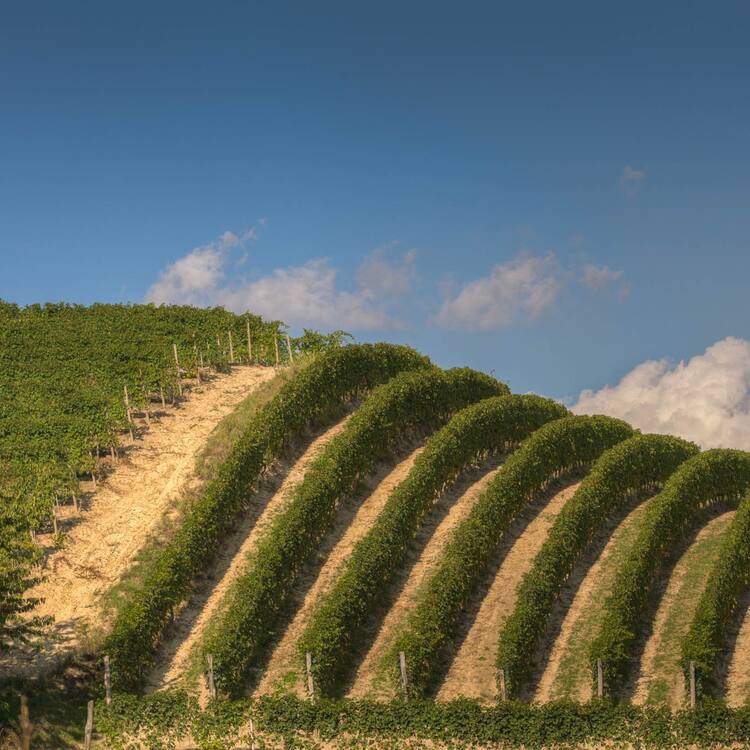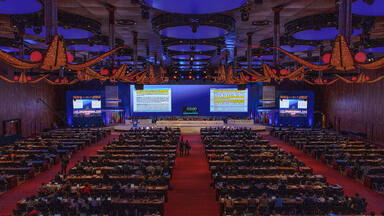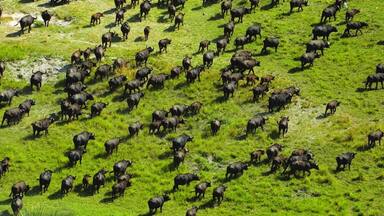Vineyard Landscape of Piedmont: Langhe-Roero and Monferrato
Vineyard Landscape of Piedmont: Langhe-Roero and Monferrato
This landscape covers five distinct wine-growing areas with outstanding landscapes and the Castle of Cavour, an emblematic name both in the development of vineyards and in Italian history. It is located in the southern part of Piedmont, between the Po River and the Ligurian Apennines, and encompasses the whole range of technical and economic processes relating to the winegrowing and winemaking that has characterized the region for centuries. Vine pollen has been found in the area dating from the 5th century BC, when Piedmont was a place of contact and trade between the Etruscans and the Celts; Etruscan and Celtic words, particularly wine-related ones, are still found in the local dialect. During the Roman Empire, Pliny the Elder mentions the Piedmont region as being one of the most favourable for growing vines in ancient Italy; Strabo mentions its barrels.
Description is available under license CC-BY-SA IGO 3.0
Paysage viticole du Piémont : Langhe-Roero et Monferrato
Ce paysage correspond à cinq vignobles distincts et au château de Cavour, dont le nom est emblématique tant du développement du vignoble que de l’histoire de l’Italie. Situé au sud du Piémont, entre le Pô et les Apennins de Ligurie, ce paysage culturel réunit l’ensemble des processus techniques et économiques liés aux vignobles et à l’élaboration du vin, une activité caractéristique de cette région depuis des siècles. Des pollens de vigne remontant au Ve siècle av. J.-C. ont été retrouvés dans l’espace du bien. À cette époque, le Piémont était un lieu de contacts et d’échanges entre Étrusques et Celtes. Des mots étrusques et celtes, en particulier ceux liés au vin, figurent encore dans le dialecte local. Durant l’Empire romain, Pline l’Ancien mentionne la région comme l’une des plus favorables à la culture de la vigne et Strabon parle des tonneaux de fabrication locale.
Description is available under license CC-BY-SA IGO 3.0
Paisaje vitícola del Piamonte: Langhe-Roero y Monferrato
Este sitio abarca cinco zonas vitivinícolas con espléndidos paisajes de viñedos y el castillo de Cavour, personaje emblemático no sólo de la historia de Italia, sino también del fomento de la vitivinicultura en la región. Situado al sur del Piamonte, entre el río Po y los Apeninos Ligures, el sitio sigue siendo el escenario de aplicación de todo un conjunto de procedimientos técnicos y económicos para el cultivo de la viña y la crianza del vino, característicos de esta zona desde muchos siglos atrás. En la región se ha encontrado polen de vid que data del siglo V a.C., época en la que el Piamonte era una zona de intercambios comerciales y culturales entre etruscos y celtas. Ambos pueblos legaron vocablos de sus respectivas lenguas relacionados con el vino, de los que todavía quedan huellas en el dialecto local. En la época del Imperio Romano, Plinio el Viejo decía ya que la región piamontesa era una de las más propicias de toda la Italia antigua para el cultivo de la viña. Por su parte, el geógrafo griego Estrabón menciona las barricas de vino de la zona.
source: UNESCO/CPE
Description is available under license CC-BY-SA IGO 3.0
ピエモンテの葡萄畑景観:ランゲ・ロエロ・モンフェッラート
ピエモンテ州南部に位置するランゲ・ロエロとモンフェッラートの、5つのワイン生産地と城からなる葡萄畑の景観。一帯では長い時間をかけて、土壌や、多くは野生種である葡萄を改良し、最適なワインづくりを発展させてきた。丘陵斜面を開墾して作り出された葡萄畑は、村落や城、ロマネスク教会、農園、ワイン販売所など周辺の風景と調和した景観を生み出している。一連の資産は、長年におよぶ葡萄栽培とワインづくりに関する技術的、経済的プロセス全般を包括している。source: NFUAJ
Wijngaardlandschap van Piemonte: Langhe-Roero en Monferrato
Het wijngaardlandschap van Piemonte bestaat uit vijf verschillende wijngebieden met prachtige landschappen en het Kasteel van Cavour, een symbolische naam in zowel de ontwikkeling van wijngaarden als de Italiaanse geschiedenis. Het gebied ligt in het zuidelijke deel van Piemonte, tussen de rivier de Po en de Ligurische Apennijnen. Het landschap omvat alle technische en economische processen die te maken hebben met de wijnbouw en -productie die deze regio eeuwenlang heeft gekenmerkt. In het gebied zijn wijnpollen gevonden uit de 5e eeuw voor Christus, toen Piemonte een plaats was waar de Etrusken en Kelten elkaar ontmoetten en handel dreven. In het plaatselijk dialect gebruikt men nog steeds Etruskische en Keltische woorden, vooral wijngerelateerd. Tijdens het Romeinse Rijk noemde Plinius de Oudere de regio Piemonte als een van de meest gunstige voor wijnbouw in het oude Italië en Strabo noemt de (wijn)vaten uit dit gebied.
Source: unesco.nl
Outstanding Universal Value
Brief synthesis
The vineyard landscapes of Langhe-Roero and Monferrato in Piedmont consist of a selection of five distinct winegrowing areas and a castle, whose names evoke profound and ancient expertise in the relationship between man and his environment. They reflect a slowly developed association between a diverse range of soils, grape varieties that are often native, and suitable winemaking processes. They offer panoramas of carefully cultivated hillsides, following ancient land divisions punctuated with buildings that lend structure to the visual space: hilltop villages, castles, Romanesque churches, farms, ciabots, cellars and storehouses for cellaring and for the commercial distribution of the wine in the small towns and larger towns on the margins of the vineyards. The serial property is outstanding for its harmony, and the balance between the aesthetic qualities of its landscapes, the architectural and historical diversity of the built elements associated with the wine production activities and an authentic and ancient art of winemaking.
Criterion (iii): The cultural landscapes of the Piedmont vineyards provide outstanding living testimony to winegrowing and winemaking traditions that stem from a long history, and that have been continuously improved and adapted up to the present day. They bear witness to an extremely comprehensive social, rural and urban realm, and to sustainable economic structures. They include a multitude of harmonious built elements that bear witness to its history and its professional practices.
Criterion (v): The vineyards of Langhe-Roero and Monferrato constitute an outstanding example of man’s interaction with his natural environment. Following a long and slow evolution of winegrowing expertise, the best possible adaptation of grape varieties to land with specific soil and climatic components has been carried out, which in itself is related to winemaking expertise, thereby becoming an international benchmark. The winegrowing landscape also expresses great aesthetic qualities, making it into an archetype of European vineyards.
Integrity
The integrity of the serial property is satisfactory, as it contains all the elements required for full expression of its values. Considered as a whole, its five components fully express the cultural, residential, architectural, environmental and productive complexity of this winegrowing and winemaking region. It bears witness to an ensemble of centuries-old traditions that have gradually been built up. The integrity of the nominated serial property is fully justified, and all the technical and social processes associated with grape production and winemaking, with a high degree of expertise, are properly illustrated.
Authenticity
The authenticity of the landscape elements and the many cultural elements of the serial property has been justified. The use of the soils, the built structures and the social organisation of all the stages of the winemaking process, from tending and harvesting the grapes to vinification, are an expression of continuity of ancient practices and expertise to form authentic ensembles in each component of the serial property. The Piedmont vineyard landscape is undoubtedly one of the most harmonious and most consistent with the ideal of a “scenic” rural and vineyard landscape, accentuated by the gently rolling hills that provide many vistas and panoramas with subtle nuances.
Protection and Management requirements
The property is protected under the Cultural Heritage and Landscape Code (Decree n°42 of 22 January 2004), under the responsibility of the Cultural Heritage Ministry and its regional agencies. It defines the responsibilities of the public regional and local authorities and the application procedures. The municipalities regulate and control permits for building and alterations. They do so with reference to municipal regulatory plans and urban development plans. The protection of the buffer zones has been confirmed by the Provincial Act of 30 September 2013.
The Management Association groups together the municipalities covered by the serial property and buffer zones, under the authority of the Region for the purpose of coordinating the conservation measures. This results in the implementation of precisely defined programmes, gathered together in the Management Plan. The Agreement Act embodies the commitment of each municipality and each administration to apply the protection measures and the sector conservation plans, and to actively participate in the management and enhancement of the property.



